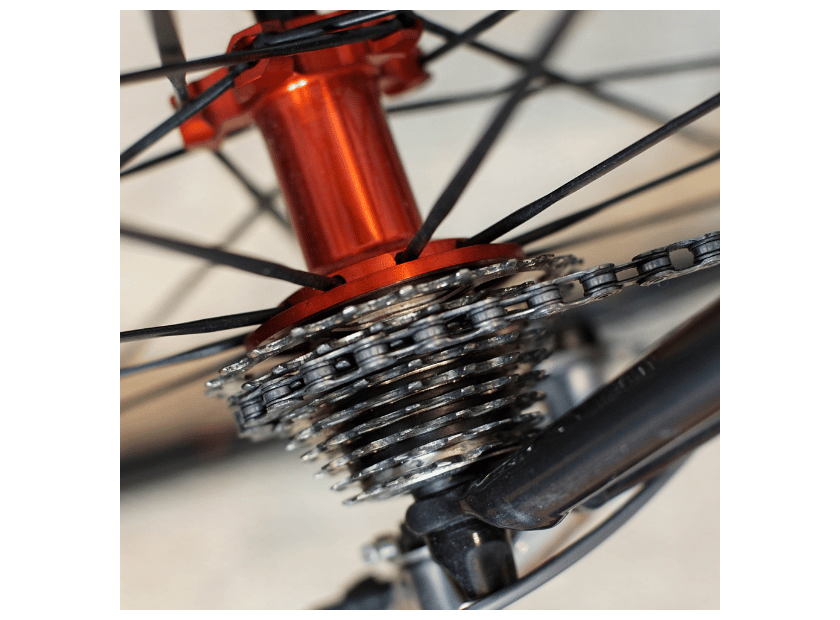The Ultimate Guide to Selecting Road Bike Rims with the Right Depth
Rim depth is key to optimal performance in road cycling. This guide explains factors influencing the choice of rim depth, including aerodynamics, weight, and handling, to help riders make an informed decision.
Understanding how rim depth affects cycling efficiency is essential. The article comprehensively compares different rim depths and their effect on speed, stability, and rider experience while avoiding personal opinion or subjective language.
What is Rim Depth and Why Does it Matter?
Speed, stability, and handling largely depend on the rim’s depth in cycling. The rim's depth is the vertical distance from the bead seat to the edge of the wheel. It affects a bike's aerodynamics and behavior in various riding conditions.
Understanding the Role of Rim Depth in Aero Performance
Rim depth plays an essential role in bicycle aerodynamics which defines how air passes through wheels. Deeper rims can smooth out airflow around tyres, thereby improving aerodynamic efficiency, allowing higher speeds on flat terrains. However, this has to be weighed against other considerations, such as individual skill levels and the bike's intended use. Primary factors that affect aerodynamics include the rim's shape, the material from which it was made, and the general design of the whole wheel assembly.
Factors to Consider When Choosing the Perfect Rim Depth
When choosing your ideal road bike’s rim depth, take into account these:
Your Cycling Goals: There are different depths for different types of riding, like more profound for more speed during races or shallower for agility when climbing mountains;
Riding Conditions: Consider what typical environmental conditions you will be dealing with. Gusty weather may require shallow rims for better control;
Weight: Acceleration and climbing involving deeper rims will always be slow because they add more mass to your bicycle;
Aerodynamics vs Handling: Deep rims improve aerodynamics but can make steering difficult, especially with crosswinds.
Impact of Rim Depth on Handling in Crosswinds
In deep rims, there is more area for the wind to push against, making crosswind handling tricky. In general, shallower rims offer better stability in gusty conditions. Factors such as rim shape and rider weight also influence how a bike responds to the wind. A compromise must be sought that delivers aerodynamic benefits without sacrificing handling too much, particularly in changeable weather conditions.
Benefits of Carbon Wheels over Alloy for Road Bikes
Carbon wheels are superior to alloy wheels due to their better aerodynamics, reduced weight, and increased stiffness. These features improve performance, especially during races and long rides.

Exploring the Aerodynamic Advantages of Carbon Wheels
Carbon wheels are designed with aerodynamics in mind. They can be molded into complex shapes, making them less resistant to moving air than aluminum alloy wheels. Rim depth, profile, and surface treatments are among key features contributing to their superior aerodynamics. Thus, they allow minimum resistance, enabling riders to achieve faster speeds using comparatively less energy.
Comparing Aerodynamics of Carbon Rims to Alloy Rims
Carbon offers a more customizable platform for aerodynamic optimization when comparing carbon rims to alloy rims. Carbon rims can be made deeper without a significant weight penalty, improving their aerodynamic efficiency. Additionally, the smooth surface of carbon rims further reduces air resistance compared to the often more textured surface of alloy rims.
The Significance of Rim Profile in Carbon Wheel Performance
The rim profile is crucial to carbon wheels’ performance. Aerodynamically optimized profiles can significantly reduce drag and crosswind sensitivity, thus increasing rider speed and stability. Careful attention is paid to factors such as the rim’s width or curve radius and the transition between the tire and the rim to resist airflow at minimal levels and ensure comfortable riding.
How Can You Assess Your Road Bike’s Performance Based on Rim Depth?
Evaluating your road bike’s performance by considering the depth of its rim requires understanding how this affects its aerodynamics and efficiency. This element greatly influences velocity, steadiness, and handling during ride environments.

Importance Of Aerodynamics In Evaluating The Performance Of A Road Bike
Aerodynamics is integral to road bike performance, especially when moving at high speed where drag becomes significant. These include but are not limited to drag, which is aimed at reducing aerodynamic rims, and crosswind stability, which may be influenced by rim depth and shape. Optimized design on aerodynamics has shown significant enhancements in both speed increase and energy provisions over the years, making it an essential factor among professionals and hobbyists.
Effect Of Rim Depth And Width On Overall Bike Performance
Rim depth and width determine a bike's rotational inertia and ability to maintain an aerodynamic profile while in motion at high speeds, respectively. Deeper rims have less drag, which increases overall speed, although they become more sensitive to crosswinds. More comprehensive, narrower widths help improve tire support and stability, offering better cornering and less rolling resistance. Balancing these two based on riding conditions and goals is vital in performance maximization.
Optimizing Rim Brake Performance With Deep Section Wheels
Deep-section wheels make a bike more aerodynamic and affect the brake interaction with the rim. Braking surface material and brake pad compatibility are crucial for efficient deceleration when working with carbon rims. Having your brake system optimized for your wheel’s material and geometry dramatically enhances safety and control when descending at high speed or executing critical maneuvers.
The Right Wheel Depth for Different Cycling Disciplines
The correct wheel depth can significantly impact performance and comfort depending on your cycling discipline. Each discipline has its ideal type of wheel, which could be aerodynamic gains in time trials or triathlons, stability in gravel biking, or general road racing performance.

Role of Wheel Depth in Time Trials and Triathlons
In time trials and triathlons, where aerodynamics plays a central role in performance, deeper wheels are preferred. This means that air resistance is much reduced for wheel depths between 60mm and 80 mm over flat to slightly undulating terrain, with the implications being faster speeds. Significant factors favoring this choice include:
Aerodynamic Efficiency: Deeper rims slice through wind effectively, thus reducing drag.
Stability in Crosswinds: Modern deep-section wheels are built to be more stable in crosswinds, making it easier to maintain control and speed up.
Rotational Mass: Although deeper wheels are somewhat heavier, their aerodynamic benefits often cancel out the incremental weight during competitions focused on time management.
Considerations for Wheel Depth in Gravel Bike and Road Racing
Lightweight for climbing, speed because of better aerodynamics, and toughness for different terrains are essential attributes required by both gravel biking and road racing. A medium-depth wheel about 40-50mm accomplishes this neatly by having;
Versatility: Medium-depth wheels provide a tradeoff between bike handling qualities and a compromise on aerodynamics that can suit many conditions encountered under gravel or road races.
Handling: For technical courses or reactive racing situations, shallower wheels allow superior handling & quick acceleration.
Durability & Comfort: Medium-depth wheels offer a more compliant ride and help reduce fatigue from longer/ rougher rides.
Effect of Wheel Depth on Rotational Performance and Speed
Among critical parameters that one should take into account is wheel depth directly influences rotational performance as well as overall speed:
Inertia: Deeper wheels have heavier rims, and this increases inertia. Consequently, they require more effort to get spinning, but once they hold on to their velocity more efficiently.
Wind Resistance: There is a smaller surface area in case the wheel depth is increased; hence, it can be used at high speeds with lesser power loss.
Acceleration: Shallower wheels are quicker to accelerate because of their reduced rotational mass, which gives them an edge in situations where speed changes frequently occur.
The choice of the right wheel depth depends on harmonizing these factors with the sport’s specific demands, personal goals, and riding preferences.
Frequently Asked Questions:
——
Q: What should I consider when selecting the depth of a rim in road bike wheels?
A: For instance, the cyclist’s mass weight, riding conditions, and proposed performance indicators must be considered when choosing road bike wheel rim depth.
Q: In what way does rim depth affect a wheelset?
A: Rim depth plays a pivotal role in the wheelset's aerodynamics and general performance. Shallow rims are usually lighter and more responsive, while deeper rims provide better aerodynamics.
Q: Can you explain how wheelsets should be chosen about aerodynamics?
A: When looking at the overall performance of A road bike, it is impossible to understate the importance of aerodynamics. Being more streamlined, they help riders achieve higher speeds with less effort.
Q: Do crosswinds affect deeper-rim wheels?
A: Shallower rims resist side winds better than their deep-rimmed counterparts. Weather conditions and terrain features of your area are other factors you must consider before deciding on your best choice rim depth.
Q: How important are carbon spokes in a wheelset?
A: Using carbon spokes, for example, enhances strength, lightness, and aerodynamic nature. Carbon-spoked wheels, therefore, perform faster and more efficiently than others made purely of steel or aluminum alloys.
Q: How can I evaluate my whole road bicycle’s performance through my wheelset choice?
A: These include aspects such as Rim Depth, Rim Width, Wheel Design, and Riding Conditions).In any case, getting matching wheels will significantly increase your pleasure during cycling endeavors.
Q: Please share information about different designs like Roval or DT Swiss
A:. To accommodate various preferences regarding cycle riding styles, brands such as Roval and DT Swiss offer diverse wheel sets. It is essential that you choose one that meets your needs or target, among other things.
References
——
Academic Papers on Bicycle Aerodynamics: They contain results of several empirical studies done by sports engineers, which, for example, highlight the impact of rim depth on aerodynamics, speed, and energy conservation.
Manufacturer Technical Guides: Websites such as Zipp.com, ENVE.com, or Mavic.com have comprehensive details about different rim depths, applications, and performance indices.
Professional Cycling Coach Blogs: These articles may be posted as various blogs by professional trainers discussing how wheel sets can be selected for different types of races based on specific rim depth requirements and course profiles.


